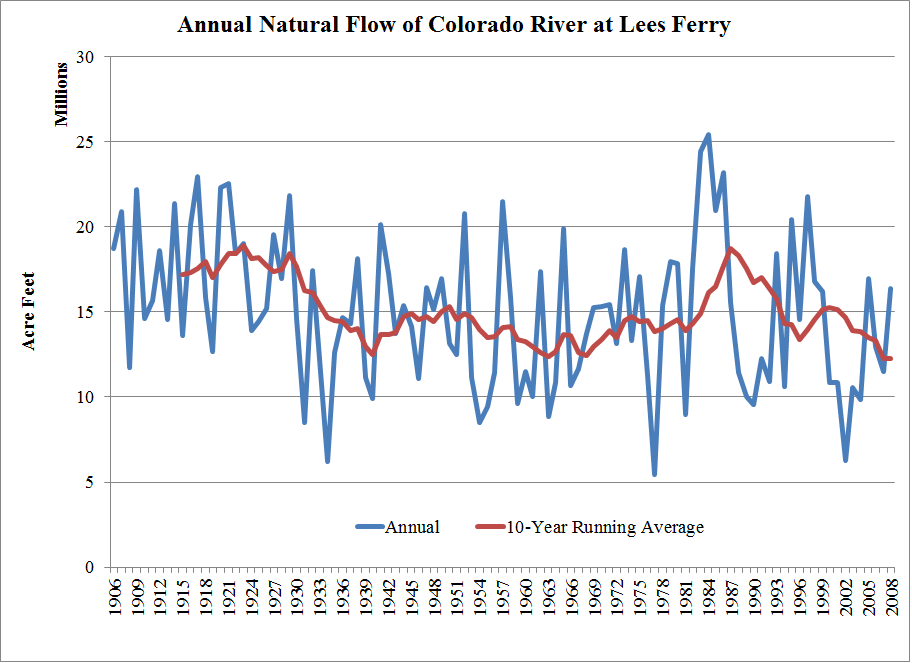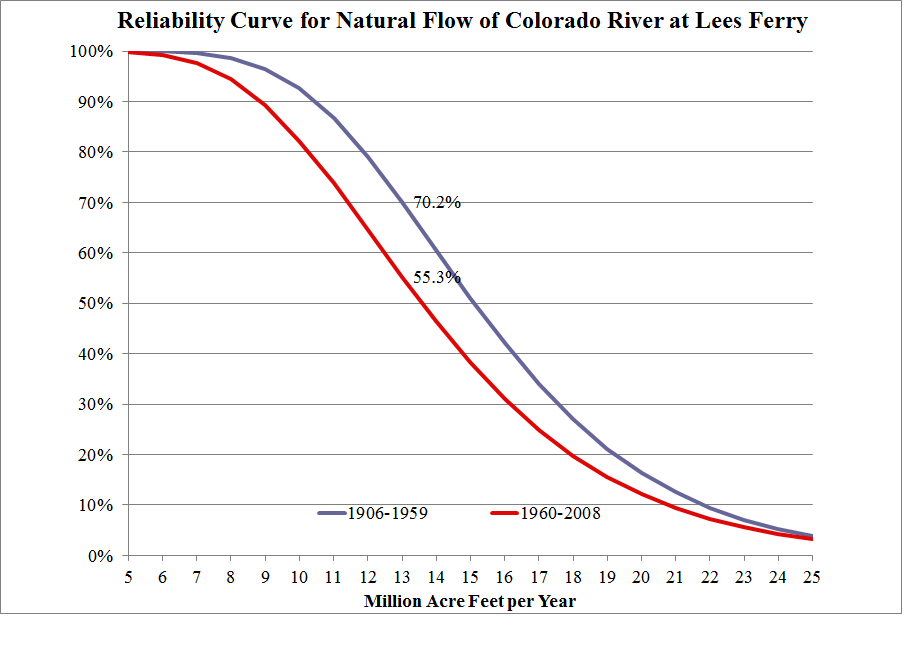Climate change received added buzz with President Obama’s second inaugural speech on January 21st. Climate change poses at least three issues for water resource management and investment:
- What is the anticipated magnitude and timing of climate change?
- Has anticipated changes already been reflected in actual hydrologic conditions?
- What does it mean and what to do about it?
For the Colorado River Basin, the issue of changing hydrologic conditions has been alive for decades and steps have already been taken. Judging by the changes in actual hydrologic conditions, the challenge is significant—especially for water users down the priority list of water rights.
Anticipated Magnitude and Timing of Changes
For the Colorado River Basin, recent climate change models are late arrivals to the discussion. Tree-ring studies decades ago concluded that the long-term average of natural flow of the Colorado River is 13.5 million-acre feet (“AF”). From this perspective, the 20th Century was an unusually wet period. With 15 million AF apportioned by the Colorado River Compact in 1922 and another 1.5 million AF committed to Mexico under the Mexico-US Treaty in 1944, many have long-characterized the Colorado as an over-appropriated river.
As a practical matter, we will not know our destination (what are the true long-term conditions) until we have completed our journey. Given that 5-day ahead weather forecasts are notoriously unreliable, why should we be surprised that there is real uncertainty about long-term hydrologic conditions?
What Has Happened to Actual Hydrologic Conditions?
The historic record of the natural flow of the Colorado River compiled by the Bureau of Reclamation supports the view that the 20th Century was an unusually wet period (see chart below). Until 1930, the annual natural flow averaged about 18 million AF. The 1930s was a decade of low flows, with the 10-year running average of natural flows declining to 12.5 million AF by 1939. The 1940s saw a recovery of natural flows so that, by 1950, the 10-year running average peaked at 15.3 million AF. The 10-year running average declined thereafter and never broke above 15 million AF until the “Colorado River floods” in the early 1980s when there were monumental flood control releases from Colorado River reservoirs. Since then, the 10-year running average marched below 13.5 million AF, only interrupted by three high flow years in the 1990s (1993, 1995, 1997). Since 2000, the 10-year running average has fallen from 15.1 million AF to 12.2 million AF in 2008 (the last year of data published by the Bureau of Reclamation on its website). If the data were a stock price, a “stock-picker” would conclude that the price is on a steady downward trend subject to large volatility.
One way to identify a change in natural flows is to break the historic record into two parts (1906-1959, 1960-2008) and compare the level and variability of annual natural flow. (Analyzing the log normal distribution of annual natural flow), the mean and variability (measured by the standard deviation of logarithm of natural flow) in annual natural flow changed from 15.7 million AF and 28.5% during 1906-1959 to 14.4 million AF and 33.1% during 1960-2008. In other words, the decline in average annual natural flow from the first half to the second half in the historic record equals about 13 million AF over a 10-year period. This decline is significant in and of itself. It is even more remarkable because the second half of the historic period includes the “Colorado River floods” of the 1980s!
Reduced natural flows, of course, translate into lower supply reliability (see chart below). The blue curve shows the reliability of natural flows during the 1906-1959 period. (Reliability measures the probability that annual natural flow will exceed the stated volume). During this first period, there was a 70% chance that annual natural flow would exceed 13 million AF. The red curve shows the reliability of natural flows during the 1960-2008 period. During this latter period, there was only a 55.3% chance that annual natural flow will exceed 13 million AF. An economist would expect increased value for senior water rights.
Management of the Colorado River, of course, includes storage to increase reliability of water supplies, especially for junior water right owners. However, storage opportunities for natural flow are lower (see chart below). Comparing the second period (1960-2008) to the first (1906-1959), annual natural flows less than 13 million AF are more likely and annual natural flows greater than 14 million AF are less likely. The greatest increases in the likelihood are annual natural flows in the range of 9 million AF to 11 million AF. The greatest reductions in the likelihood are annual natural flows in the range of 16 million AF to 18 million AF. Storage opportunities are increasingly based on waiting for low probability, highest flow periods. The expected natural flows in excess of 16 million AF per year are 4 million AF lower over a 10-year period.
A critical question for the basin: are current conditions a drought or are they simply a return to long-term average conditions? Another century of data should prove useful in settling the scientific question. In the interim, the steady decline in annual natural flows from the early to the late 20th century and into the 21st century suggest that a reasonable bet is that natural flows are more likely to reflect long-term conditions predicted by tree-ring studies than the high-flow years of the early 20th century.
What Does This Mean?
Colorado River basin interests have been proactive. Recognizing the prospect of water shortages, they have devised shortage-sharing policies among themselves and, recently through Minute 319, with Mexico. Consistent with the reduced natural opportunities for storage, they have created a right to store “intentionally created surplus” in Lake Mead based on water conservation.
The size of the challenges is great. The loss of 13 million AF of natural flow, including 4 million AF of storage opportunities over a 10-year period is significant. While intentionally created surplus is an important tool, the pressure for further water conservation will intensify. Without leadership, urban-rural conflict can grow between the high-priority water right owners (generally agricultural water users) and the low-priority water right owners (generally urban water users).
The timing of the recently released report Water Transfers in the West by the Western Governors’ Association and the Western States Water Council could not be better. See my next post.



